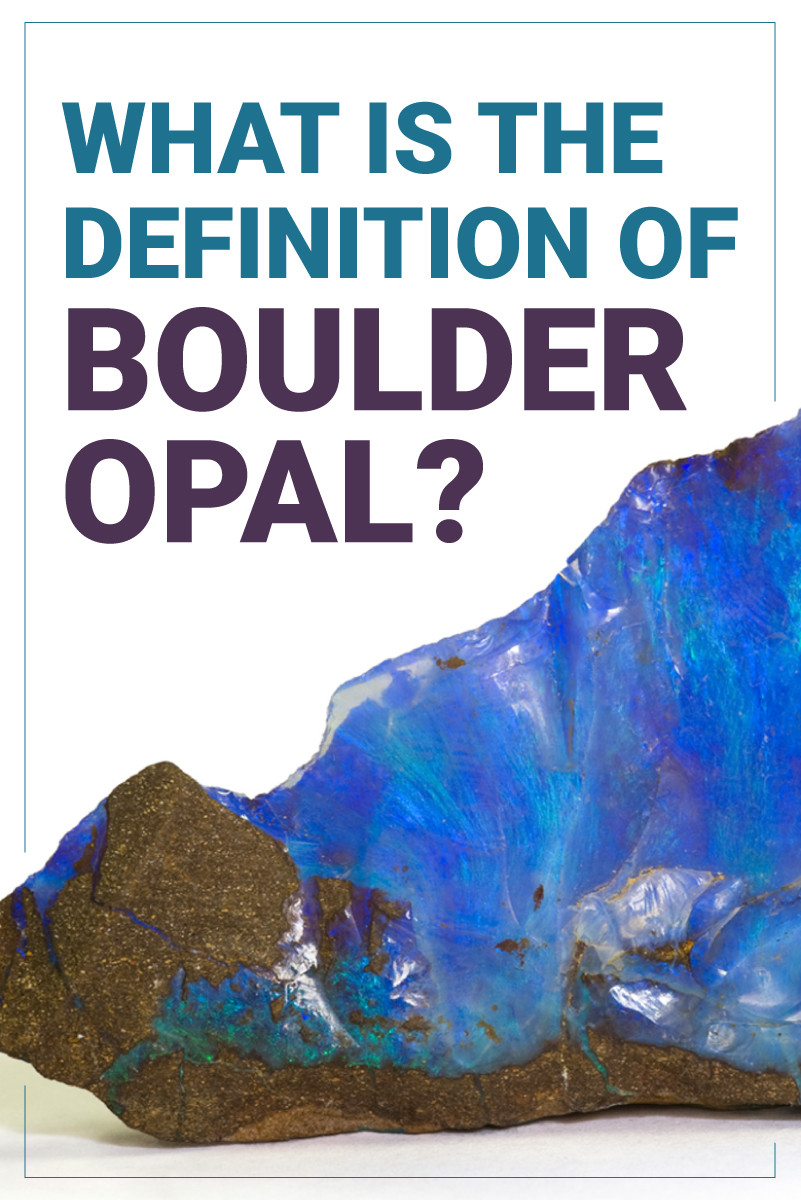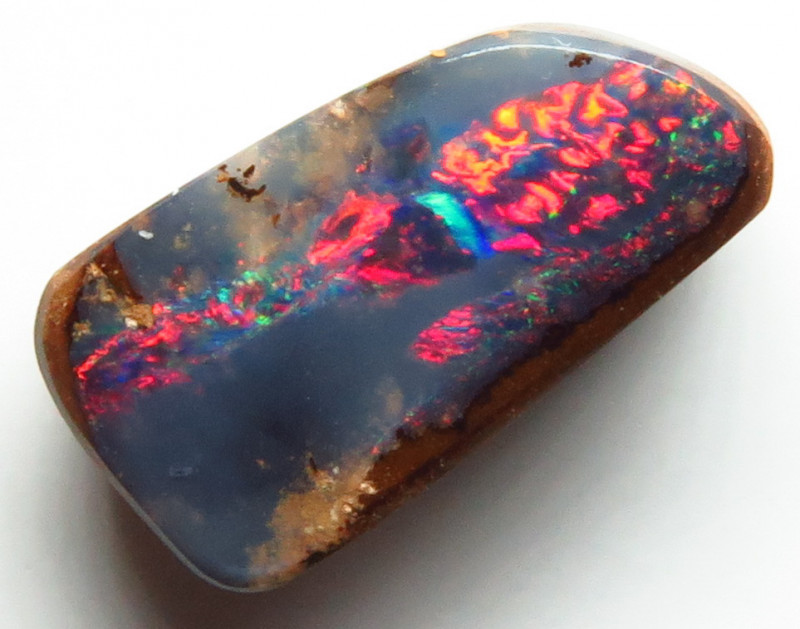
Publicado en 29th Oct 2020
Modificado en 17th Nov 2025
¿Qué es el ópalo de roca? 5 preguntas frecuentes respondidas
 Como veteranos de la industria del ópalo, hablamos mucho sobre ópalos aquí en el blog. Hoy, abordamos uno de los ópalos más fascinantes: el ópalo de roca. ¿Qué es un ópalo de roca?
Como veteranos de la industria del ópalo, hablamos mucho sobre ópalos aquí en el blog. Hoy, abordamos uno de los ópalos más fascinantes: el ópalo de roca. ¿Qué es un ópalo de roca?
En esta guía, respondemos a esa pregunta y a otras cuatro preguntas frecuentes sobre los ópalos de roca. Vamos directamente a la información que necesitas para comprender mejor esta fascinante gema.
¿Primero? Definamos qué es el ópalo de roca.
¿Qué es el ópalo de roca?
El ópalo de roca es una gema única que contiene fragmentos de la roca madre de hierro de la que se formó, junto con ópalo precioso. Los ópalos de roca se presentan en una variedad de colores y patrones, y provienen principalmente de Queensland, Australia.
Cuando un lapidario (tallador de gemas) recibe un ejemplar de ópalo de roca, lo analiza meticulosamente para exhibir la preciosa gema de la mejor manera. Se requiere mucho cuidado y atención al tallar la gema para asegurar que la roca madre permanezca intacta. Existen varias maneras de hacerlo:
Corte la roca madre para mostrar uniformemente parches y bolsas de ópalo en toda la piedra de hierro.
Talla la gema para mostrar mejor las vetas de ópalo precioso que la recorren.
O córtelo de manera que el ópalo aparezca como la superficie, y la loza de hierro parezca un tono base o un fondo.
El ópalo de roca es especialmente útil porque minimiza el desperdicio. Fragmentos y vetas que de otro modo serían demasiado pequeños para tallar en gemas de ópalo se conservan en el ópalo de roca. Entonces, si el ópalo de roca proviene de rocas ígneas, ¿dónde se encuentra en el mundo?
¿Dónde se encuentra el ópalo de roca?
La mayor parte del ópalo proviene de Australia, y el ópalo de roca no es la excepción. Si quieres saber dónde encontrar ópalos de roca, dirígete a Queensland. Los ópalos se forman a lo largo de millones de años, pero aún aquí se pueden encontrar ópalos adheridos a la roca madre. Algunos ópalos están adheridos a arenisca y otros a hierro, dependiendo de las condiciones geológicas y la ubicación donde se formaron.
Por supuesto, existen otras fuentes de ópalo de roca en México y Honduras. Sin embargo, la variedad más famosa es el ópalo de roca australiano , gracias a la presencia de hermosas vetas de hierro en la gema.
El ópalo australiano de roca es fácilmente identificable gracias a la mezcla de roca huésped y ópalo. Como ocurre con la mayoría de los ópalos, existen innumerables variedades de este ejemplar único, desde el ópalo matriz hasta el ópalo coloreado y el ópalo Yowah.
Los yacimientos de ópalo de roca más famosos de Queensland son Winton, Opaltown, Jundah, Quilpie, Kyabra, Bulgaroo, Koroit y Yowah. Los dos últimos están relativamente cerca entre sí y son reconocidos por sus patrones, colores y estilos únicos. Naturalmente, los ópalos de cada yacimiento varían en color, forma, veta y apariencia. 
¿Cómo se forma el ópalo de roca?
Cada ópalo de roca es completamente único. Por ejemplo, los ópalos de Koroit y Yowah presentan un fondo de hierro oscuro en tonos chocolate. En cambio, otros ópalos de roca muestran la característica coloración caramelo y marrón claro de la arenisca. Las características de cada ópalo son resultado directo de su formación.
Hablando de eso, el proceso de formación es increíble. Todos los ópalos se forman a lo largo de millones de años, pero los ópalos de roca tienen un proceso de crecimiento y extracción único. Durante milenios, diminutas capas de esferas de sílice se endurecen y crecen hasta formar un ópalo. Como su nombre indica, provienen de enormes rocas de hierro bajo la superficie terrestre. Las vetas de ópalo crecen y se forman en las grietas y fracturas de la roca.
Estas vetas son increíblemente finas y se filtran por las pequeñas aberturas de la roca madre. Cuando los mineros extraen los ejemplares, tienen que cortar la roca madre debido a la extrema delgadez de las vetas de ópalo.
Si los mineros cortaran directamente las vetas de ópalo, se comprometería la calidad de la piedra. Si bien el resultado es magnífico, la presencia de la roca madre sí afecta el valor general de la piedra.
¿Qué valor tiene el ópalo de Boulder?
De todas las variedades de ópalo disponibles, el ópalo de roca es sin duda el más asequible. Esto se debe a su alto contenido en roca huésped. La proporción de ópalo precioso y roca huésped varía, pero en general, el ópalo de roca es mucho más asequible precisamente porque no es 100% ópalo precioso.
Tenga cuidado de no confundir los ópalos de roca auténticos con los dobletes. Un doblete de ópalo suele contener una base de plástico o sintética, mientras que la roca huésped de los ópalos de roca es completamente natural.
Volviendo al valor del ópalo de roca, su bajo precio es lo que lo hace tan accesible y atractivo para los compradores. El factor determinante de su valor es la calidad y cantidad del mineral de hierro. Si un ópalo de roca contiene principalmente mineral de hierro, su valor será bajo, ya que el componente valioso es el ópalo precioso.
Si encuentras un ópalo de superficie limpia con mínimas inclusiones de hierro, sin duda pagarás un precio más alto por él. Como ocurre con todos los ópalos, su valor depende de la calidad, la procedencia y la apariencia de la gema. 
¿Cómo se cuida un ópalo de roca?
Ya hemos hablado anteriormente sobre cómo cuidar los ópalos, y el proceso es bastante similar para los ópalos de roca. Los ópalos son un material blando con una dureza de 5,5 a 6 en la escala de Mohs. En cambio, la piedra de hierro es muy dura, lo que aumenta su durabilidad. Dicho esto, conviene evitar que el ópalo de roca reciba golpes fuertes.
Para cuidar mejor tu ópalo, sigue estos consejos de seguridad y longevidad:
Quítese las joyas de ópalo antes de realizar actividad física, limpiar, lavarse las manos o practicar deportes.
Guarda los ópalos separados de gemas más duras como diamantes o zafiros. Cualquier superficie más dura que el ópalo puede rayar o dañar la gema, por lo que es mejor guardarlos en un joyero seguro o una bolsa de tela.
Limpie sus ópalos de roca regularmente con un cepillo de cerdas suaves, un paño y agua tibia jabonosa. Evite los detergentes fuertes o los productos químicos que puedan dañar la gema.
Programe una limpieza rutinaria anual o bianual con su joyero para asegurarse de que los engastes de la piedra estén bien ajustados y evitar perder la gema.
Ópalos de roca: ¡Una gema dinámica de la familia de los ópalos!
Si tuviéramos que resumir los ópalos de roca en una sola palabra, sería inigualable.
Existen millones de ópalos en el mundo, pero pocos son tan extraordinariamente únicos como los ópalos de roca. Con la yuxtaposición del ópalo brillante y la terrosa piedra de hierro, sería difícil encontrar una gema tan distintiva y característica como los ópalos de roca.
¿Listo para explorar el catálogo y encontrar la última incorporación a tu colección?
¡Explora hoy mismo los ópalos de roca!
Buscar en el Opal Encyclopedia
Subastas relacionadas
Artículos relacionados
El ópalo de roca es uno de los ópalos más valiosos y subestimados del mercado. Descubra más sobre este ópalo único y explore las hermosas piedras que tenemos a la venta.
29th May 2019
Apasionados por los ópalos, Wayne y Estella Sedawie fundaron Opal Plus hace más de 14 años y han descubierto que internet es una herramienta valiosa. Es donde se realizan la mayoría de las transacciones internacionales de la empresa.
17th Oct 2018
últimos artículos
Los ópalos negros son la variedad más codiciada, con bases profundas que crean un arcoíris de reflejos en la parte superior. ¡Descubre los usos, las propiedades, la historia y el valor de los ópalos negros!
7th Dec 2025
Descubra cómo se clasifican los ópalos y qué factores influyen en su precio. Desde el color y el brillo hasta la talla y el origen, aprenda cómo se valora cada tipo de ópalo, con ejemplos de rangos de precios.
19th Jul 2023
¡Acompáñanos en un viaje y descubre el poder curativo de los ópalos de la mano de nuestra escritora invitada Vivien Schapera, de Crystal Healing Techniques!
20th May 2023
Categorías de artículos
All there is to know about Opals including Black Opals, Ethiopian Opals & Boulder Opal
14 Artículos
Check out our fascinating information and articles on all things amazing in the Opal world
41 Artículos
Opal Auctions sellers who are approved as opal Verified Sellers
4 Artículos




![925 ST/ SILVER RHODIUM PLATED BLACK OPAL RING [FR1]](https://liveplatforms-production.b-cdn.net/tenants/oa/uploads/images/895000-899999/898447/5ee04d3e43513.jpg?width=480&aspect_ratio=1001%3A1000)

![18K GOLD BLACK OPAL RING GOLD AND DIAMONDS [CR83]](https://liveplatforms-production.b-cdn.net/tenants/oa/uploads/images/995000-999999/995801/6007fc434bdfa.jpg?width=480&aspect_ratio=1001%3A1000)
